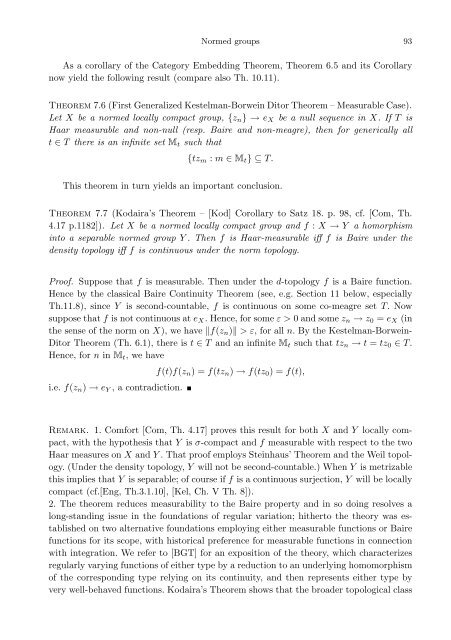Normed versus topological groups: Dichotomy and duality
Normed versus topological groups: Dichotomy and duality
Normed versus topological groups: Dichotomy and duality
Create successful ePaper yourself
Turn your PDF publications into a flip-book with our unique Google optimized e-Paper software.
<strong>Normed</strong> <strong>groups</strong> 93As a corollary of the Category Embedding Theorem, Theorem 6.5 <strong>and</strong> its Corollarynow yield the following result (compare also Th. 10.11).Theorem 7.6 (First Generalized Kestelman-Borwein Ditor Theorem – Measurable Case).Let X be a normed locally compact group, {z n } → e X be a null sequence in X. If T isHaar measurable <strong>and</strong> non-null (resp. Baire <strong>and</strong> non-meagre), then for generically allt ∈ T there is an infinite set M t such that{tz m : m ∈ M t } ⊆ T.This theorem in turn yields an important conclusion.Theorem 7.7 (Kodaira’s Theorem – [Kod] Corollary to Satz 18. p. 98, cf. [Com, Th.4.17 p.1182]). Let X be a normed locally compact group <strong>and</strong> f : X → Y a homorphisminto a separable normed group Y . Then f is Haar-measurable iff f is Baire under thedensity topology iff f is continuous under the norm topology.Proof. Suppose that f is measurable. Then under the d-topology f is a Baire function.Hence by the classical Baire Continuity Theorem (see, e.g. Section 11 below, especiallyTh.11.8), since Y is second-countable, f is continuous on some co-meagre set T. Nowsuppose that f is not continuous at e X . Hence, for some ε > 0 <strong>and</strong> some z n → z 0 = e X (inthe sense of the norm on X), we have ‖f(z n )‖ > ε, for all n. By the Kestelman-Borwein-Ditor Theorem (Th. 6.1), there is t ∈ T <strong>and</strong> an infinite M t such that tz n → t = tz 0 ∈ T.Hence, for n in M t , we havei.e. f(z n ) → e Y , a contradiction.f(t)f(z n ) = f(tz n ) → f(tz 0 ) = f(t),Remark. 1. Comfort [Com, Th. 4.17] proves this result for both X <strong>and</strong> Y locally compact,with the hypothesis that Y is σ-compact <strong>and</strong> f measurable with respect to the twoHaar measures on X <strong>and</strong> Y . That proof employs Steinhaus’ Theorem <strong>and</strong> the Weil topology.(Under the density topology, Y will not be second-countable.) When Y is metrizablethis implies that Y is separable; of course if f is a continuous surjection, Y will be locallycompact (cf.[Eng, Th.3.1.10], [Kel, Ch. V Th. 8]).2. The theorem reduces measurability to the Baire property <strong>and</strong> in so doing resolves along-st<strong>and</strong>ing issue in the foundations of regular variation; hitherto the theory was establishedon two alternative foundations employing either measurable functions or Bairefunctions for its scope, with historical preference for measurable functions in connectionwith integration. We refer to [BGT] for an exposition of the theory, which characterizesregularly varying functions of either type by a reduction to an underlying homomorphismof the corresponding type relying on its continuity, <strong>and</strong> then represents either type byvery well-behaved functions. Kodaira’s Theorem shows that the broader <strong>topological</strong> class
















